BIOGRAPHY
As one of Indiana’s
best-known authors, Gene Stratton-Porter left an indelible
mark on the state's history. Her writing started out as a
way to make a little extra money, but it eventually made her
a world famous author and naturalist. Most people know of
Stratton-Porter from her two most famous novels, Freckles
and A Girl of the Limberlost. However, many people
are unaware that she wrote many of her novels to support her
non-fiction writing.
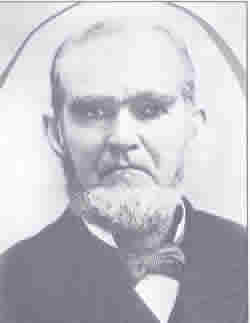 |
Mark Stratton
|
Geneva Grace, later known as Gene, came as a
surprise to her parents, Mark and Mary Stratton. On August
17, 1863, in the small town of Lagro, located in Wabash
County, the couple gave birth to the youngest of their
twelve children. Mary was not well in the years following
Gene’s birth and with a family the size of the Strattons',
there was little time to watch over the youngest. She learned
to play by herself in the outdoors and this solitude became
the foundation for her love of nature.
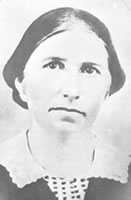 |
| Mary Stratton
|
However, her happy times on the farm ended with
a series of tragedies that began when she was eight years
old. Her favorite brother, Laddie, drowned on July 6, 1872.
Her brother’s death left a hole in Gene’s heart
and a huge problem for her father. Laddie had been the only
member of the family interested in continuing with farming.
Mark Stratton was sixty years old at the time of his son’s
death and was getting too old to farm. On top of it all, Mary
was still very ill.
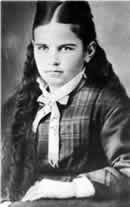 |
Gene Age
10 |
In 1875, the family moved from the dearly loved
farm to Largo to stay with one of their daughters. Four months
later, Mary died. After her death, the Stratton family moved
often, living at the homes of Gene's siblings. When Gene was
twenty, she met her future husband.
Charles Porter was a successful druggist and
self-made businessman in Geneva,
Indiana. He first saw Gene when they both attended a Chautauqua
at Island Park Assembly, which was a religious revival, located
on Sylvan Lake. They took up a writing correspondence and
Charles soon asked her to marry him. On April 21, 1886, Geneva
Grace Stratton married Charles Porter and the couple moved
to Decatur, Indiana.
Gene was very unhappy in her first home. Her
husband was constantly traveling between his two stores in
Geneva and Ft. Wayne,
leaving her alone with nothing to do in their small town.
Thankfully, her loneliness did not last long; their first
and only child, Jeannette Stratton-Porter, was born on August
27, 1887. Although Stratton-Porter was no longer lonely, she
found the confined conditions of her home now unbearable with
the new baby.
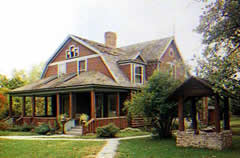 |
Limberlost
Cabin.
Copyright, Indiana State Museum Shop. |
Soon after the birth of Jeannette, the Stratton-Porter
family moved to Geneva to be closer to one of Charles’s
drug stores. Geneva was an ideal town for Stratton-Porter
because it was near something she was familiar with-- the
Wabash River and her old farmstead. In 1888, Charles Porter
bought his wife a small cottage in the town near his drug
store. The home proved to be too crowded for the family and
they began to build Limberlost Cabin in 1894. In 1895, the
very fine home, costing an astronomical amount, became the
envy of the town.
Gene flourished in Geneva but also became very
frustrated with the naturalists of her time. There were very
few books written about nature and no books available could
answer her questions. In order to find the answers she sought,
Gene Stratton-Porter began to study the birdlife of the upper
Wabash and record her observations. By conducting these studies,
she was able to answer questions about bird physiology and
habits.
Gene’s next problem involved photography.
The only photographs ever taken of birds or animals portrayed
subjects that were dead and stuffed. Gene wanted realistic
photos and sought these pictures in the Limberlost
Swamp. She would photograph and study the wildlife in
the Limberlost for years, recording her findings and turning
those observations into both fiction and non-fiction books.
The Limberlost became a favorite place for Gene and she despaired
when the beautiful trees and natural habitats were cleared
for farmland. Oil drilling also destroyed the land, and she
opposed this practice as well, in spite of the fact that her
husband owned many oil rigs.
When Gene started putting
her observations into books, she found out there were few
publishers that would accept her naturalist writings. To make
her nature books possible, an agreement was made between Stratton-Porter
and her different publishers, such as Bobbs-Merrill, Doubleday,
and Page and Company. Her publishers had serious doubts that
her naturalist books would sell as well as her fiction, so
she agreed to write novels to compensate for the money she
lost on her non-fiction works. Although these non-fiction
works never sold as well as her novels, they were very popular
among some readers.
For example, Moths of the Limberlost
is a natural history study that describes in detail the work
Stratton-Porter accomplished with the moths around her home.
The work was written when readers demanded more information
on the moths found in her novel, A Girl of the Limberlost.
Similarly, What I Have Done With Birds started out
as a study published in a few articles of Ladies Home
Journal, but due to public demand for more information,
Stratton-Porter happily wrote the work to tell all she knew.
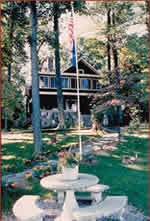 |
Wildflower
Woods. Copyright, Indiana State Museum. |
With each work she published, Stratton-Porter’s
fame grew. The public wanted to know more about this strange
woman who ignored social protocol for proper ladies and instead
trodded through dangerous swamps to find more information
on all types of wildlife. Stratton-Porter fans were flocking
to Geneva to visit the famous author. Although their intentions
were well-meant, they soon began to crowd the very private
Stratton-Porter. To escape the attention of her fans, she
left Geneva in 1912 for Sylvan Lake in Rome City. Here, she
bought a small cottage for a short time before searching for
land to build a new house. In October, she found the land
she wanted and began construction on Wildflower Woods. “Out
of more than fourteen thousand trees, vines, shrubs, and wildflowers
that she found or bought and planted, 90 percent were set
by her own fingers” (Long 196). Many of the plants found
at Wildflower Woods were endangered. However, because of the
habitat created by Stratton-Porter, these plants are now flourishing.
Stratton-Porter remained at Wildflower Woods,
planting and creating havens for her bird friends until 1918,
when she could take the destruction of the land around her
no longer. She moved to the beautiful landscape of southern
California and remained there, writing several more books,
producing quite a few movies, and even starting to publish
some of her poetry. However, her poetry does not focus on
Indiana's environment. Stratton-Porter lived in California
until her death at the age of sixty, on December 6, 1924,
when she suffered fatal injuries from an automobile accident.
FICTION
Gene Stratton-Porter is best known for her novels
Freckles (1904) and A Girl of the Limberlost
(1909), which put Geneva,
Indiana, and the Limberlost
Swamp on the map. Of all her books, these two have most
successfully brought attention to Indiana's environmental
concerns. Readers who are completely in tune with nature and
who find fulfillment through its healing qualities are easily
absorbed into the characters of her novels.
The Song of the
Cardinal (read
full text), published in 1903, was Gene Stratton-Porter’s
first novel. It tells the story of a male cardinal living
his life on the land of a farmer who has promised sanctuary
for all birds residing there. Porter was inspired to write
the book when she found a dead cardinal, the victim of thoughtless
sport. She was so irate that she wrote this book in response.
The book centers around a cardinal who is separated
from his family and must live on his own. He flies until he
finds an orchard to live in, and there he meets Abram, who
talks to him, offering advice and protection.
Abram, the farmer, was clearly based on Stratton-Porter's
father, who in her childhood promised her all the birds on
his land as a gift. They would be protected from hunters as
long as he owned the land.
Abram regards the cardinal as an equal, and this
concept of equality is explored as the book progresses. Through
the song of the cardinal, Abram and Maria, his wife, gain
a stronger appreciation of nature.
[Abram’s] heart was big with happiness.
It was the golden springtime of his later life. The sky
never had seemed so blue, or the earth so beautiful. The
Cardinal had opened the fountains of his soul....
(103) (extended
quote)
Another manifestation of this appreciation is
apparent when at one point in the novel, a young man is caught
hunting on the land, and Abram explains to him why he should
not kill for sport. The boy is so sorry for his actions that
he confesses his wrongdoing, drops his gun, and runs off of
the property.
Stratton-Porter's next
novel, Freckles
(read full text), was published
in 1904. It is the story of a young orphan, nicknamed Freckles,
who has only one hand. Because he is different, Freckles has
faced harsh treatment throughout his life, but he eventually
obtains a job working for McLean, the manager of a big lumber
company. Freckles must live in the Limberlost
and protect it for the next year. Although he is alone, the
experience of living in the swamp proves to be beneficial.
When the first breath of spring touched
the Limberlost... and the pulse of the newly resurrected
season beat strong in the heart of nature, something new
stirred in the breast of the boy.
Nature always levies her tribute. Now
she laid a powerful hand on the soul of Freckles, to which
the boy’s whole being responded, though he had not
the least idea what was troubling him.... Clean, hot, and
steady the blood pulsed in his veins. He was always hungry,
and his hardest day’s work tired him not at all....
He had taken on flesh and colour, and developed a greater
strength and endurance than any one could ever have guessed.
(40-1)
(extended quote)
Being in nature strengthens Freckles,
both mentally and physically. He is bribed to let McLean's
ex-workers cut down a few trees, but he refuses the money
instead of betraying his duties.
Freckles meets and falls in love with Swamp
Angel, a frail but beautiful young woman who lives in the
Limberlost with the Bird Woman. This was a real-life nickname
for Gene Stratton-Porter, and like the author, the Bird Woman
photographs birds and collects insects.
“[The Bird Woman is] dead down on
anybody that shoots a bird or tears up a nest. Why, she’s
half killing herself in all kinds of places and whether
to teach people to love and protect the birds. She’s
that plum careful of them that Jim’s wife says she
has Jim a standin’ like a big fool holding an ombrelly
over them when they are young and tender until she gets
a focus, what ever that is. Jim says there ain’t a
bird on his place that don’t actually seem to like
to have her around after she has wheedled them a few days,
and the pictures she gets nobody would ever believe that
didn’t stand by and see them taken.” (114)
Freckles helps the women with their nature studies
and provides them protection. Like Stratton-Porter herself,
the Swamp Angel condemns the destruction
of the forests, as in this passage:
“Oh, what a shame!” cried
the Angel. “They’ll clear out roads, cut down
the beautiful trees, and tear up everything. They’ll
drive away the birds and spoil the cathedral. When they
have done their worst, then all these mills about here will
follow in and take out the cheap timber. Then the land-owners
will dig a few ditches, build some fires, and in two summers
more the Limberlost will be in corn and potatoes.”
(182-3)
At the Foot of
the Rainbow,
(read full text) published in 1907,
is the story of two life-long friends, Jimmy Malone and Dannie
Micnoun. They live near Rainbow Bottom along the Wabash River,
where they hunt, fish, and tend their farms.
The two characters have many differences; Jimmy
often misunderstands his surroundings, but Dannie is in touch
with the Earth. By emphasizing their dissimilar approaches
to nature, Stratton-Porter shows readers the value of appreciating
the environment. Here Dannie expresses his wonder at the splendor
of Rainbow Bottom:
“I dinna think there is ony place
in all the world so guid as the place ye own,” Dannie
said earnestly.... “I dinna give twa hoops fra the
palaces men rig up, or the thing they call ‘landscape
gardening.’ When did men ever compete with the work
of God...? The thing God does is guid enough for me.”
(103-5) (extended
quote)
Jimmy is interested in material things, but Dannie
finds the forest
and all of nature fascinating and full of life. He prefers
natural beauty over artificial “landscape gardening,”
and he compares Rainbow Bottom to an endless pot of gold,
a marvelous wealth of infinite beauty.
Stratton-Porter's most famous
novel, A Girl of the Limberlost (read
full text), was published in 1909. It is the story
of Elnora Comstock, a girl who lives in the Limberlost with
her widowed mother. (read
quote)
Elnora convinces her mother to let her go to
school, but when she arrives, she is embarrassed by her inferior
clothes and lack of textbooks. Mrs. Comstock refuses to buy
Elnora's books, so she sets out to earn the money herself.
Elnora responds to a sign in a bank window offering
cash for caterpillars, cocoons, chrysalides, pupae cases,
butterflies, moths, and Indian relics of all kinds. Having
explored the Limberlost
and amassed an extensive collection of insects and other specimens,
Elnora finds the Bird Woman, who had posted the sign, and
soon has the money she needs for school. (read
quote) However, that money runs out over the next
few years, so Elnora must once again begin collecting.
At one point, Mrs. Comstock spots an insect in
the house and kills it before Elnora can stop her. The insect
is a Yellow Emperor, a rare moth which Elnora needs to complete
a set worth 300 dollars. To rectify her mistake, Mrs. Comstock
goes into the Limberlost to search for a Yellow Emperor herself.
As Elnora and her mother find insects together, their relationship
grows stronger.
While searching with her mother one day, Elnora
meets a man in the forest who offers to help her cut a cocoon
from a log.
“It’s going to be a fair job
to cut it out, but when it comes, it is not only beautiful,
but worth a price; it will help you on your way. I think
I’ll put up that rod and hunt moths." (264)
(extended quote)
The man, named Philip
Ammon, has been instructed by his doctor to spend time outdoors
to recover from typhoid fever. He decides to help Elnora with
her hunting since he must exercise outside anyway.
Philip and Elnora spend the summer together hunting
moths and other insects. She obtains a job at the school teaching
about the wilderness. Elnora and Philip become good friends
and eventually get married.
The Harvester
(read full text), published in
1911, tells of a man who lives his life in the woods collecting
plants for medicinal use and selling them to chemists. The
Harvester has a dream of a beautiful girl and devotes his
time and effort to finding her. (read
quote) He lives most of his life in the 600 acres
of a forest called Medicine Woods, and collects plants from
surrounding areas to grow on his own property.
Six years he had worked cultivating these beds,
and hunting through the woods on the river banks, government
land, the great Limberlost Swamp, and neglected corners of
the earth for barks and roots. He occasionally made long trips
across the country for rapidly diminishing plants he found
in the woodland of men who did not care to bother with a few
specimens, and many big beds of profitable herbs, extinct
for miles around, now flourished on the banks of Loon Lake,
in the marsh, and through the forest rising above. (26)
The Harvester eventually does find his “Dream
Girl,” whose real name is Ruth Jameson. Ruth is ill
when the Harvester first meets her, and he tries to cure her
from her sickness, teaching her, in the process, about the
forest and its many uses. They marry, but she does not yet
love him. Again, Ruth becomes very ill and nearly dies, and
when none of the doctors can help her, the Harvester treats
her with a concoction of his own. He continues to care for
her, and by healing her body and her soul, he finally wins
her love.
Many aspects of the Harvester’s life in
the woods affect his personality and actions throughout this
book. They are his respect for nature and the way this respect
is tied to his religion. (read
quote)
He respects nature and does not take from it
in excess. “I must have a mighty good reason before
I kill…. I cannot give life; I have no right to take
it away” (173).
As important as nature is to him, there is something
that holds a higher priority: his religion. His is a simple
religion but he is very devoted to it. His respect and wonder
at nature stems from his religion. He expresses it in the
woods
where he works and lives. "My work keeps me in the woods
so much I remain there for my religion also. Whenever I find
these flowers I always pause for a little service of my own..."
(183).(extended
quote)
The Harvester ties together well the ideas of
nature and religion. (read
quote) This was a concept of which Stratton-Porter
was very fond. Through this connection, greater importance
is put on nature, which is what she wants to do in order to
help preserve it. The Harvester conveys this idea to the reader.
In 1913, Stratton-Porter
published Laddie: A True Blue Story
(read full text), which is strongly
based on her own life. The narrator, Little Sister, is a girl
who lives on a farm with her older siblings. (read
quote) The oldest of these siblings, Laddie, is
a strong influence on her life.
Little Sister's is interested in nature and that
interest can be clearly traced to her father:
Every few days I followed the lane as far
back as the Big Gate. This stood where four fields cornered,
and opened into the road leading to the woods.
Beyond it, I had walked on Sunday afternoons with father
while he taught me all the flowers, vines, and bushes he
knew, only he didn't know some of the prettiest ones….(8)
(extended
quote)
As Little Sister grows, she realizes
the value of experience in learning about nature. Although
schooling and books teach her the names of plants and animals,
it is only by being outside and observing her environment
that she truly learns about nature. (read
quote)
Like Stratton-Porter, Little Sister was not meant
for a life indoors. Her joy in life is being with nature,
not living and working in confined rooms. (read
quote) This novel is a good one to read
to understand Stratton-Porter’s childhood and how it
later affected her life and work. It is as important as a
biography, because it is written by Stratton-Porter about
herself.
Stratton-Porter's novels have touched the lives
of countless Hoosiers, as well as many others. Her fictional
works reveal an environment where many of her characters have
grown and been healed by nature. Unfortunately much of that
environment no longer exists today.
--BJF
NON-FICTION
Gene Stratton-Porter may be best known for her
novels, but her true love was writing about natural history.
Most of her novels were only written to fund her nature writing.“[I]t
was her clear objective to promote the preservation
of the physical landscape that inspired…her” (Vanausdall
103). She could often be found in the swamp,
photographing, studying, and writing about the animals around
her. The biographer Frederic Cooper commented:
Gene Stratton-Porter lives in a swamp, arrays herself in
man’s clothes, and sallies forth in all weathers to
study the secrets of nature. I believe she knows every bug,
bird, and beast in the woods…She
is primarily a naturalist, one of the foremost in America
and has published a number of books on flora and fauna…
These books—which are closest to her heart—have
only a moderate sale. (670)
Several of her natural history books contain
her photography of living specimens she found in the Limberlost
swamp. Birds and moths were her favorite subjects to write
about and photograph, but her interest reached beyond these
creatures. She became an expert on Indiana’s natural
world, particularly her beloved Limberlost. In Gene Stratton-Porter:
A Lovely Light, she is quoted:
I was born in this state, have always lived
here and hope to die here. It is my belief that to do strong
work any writer must stick to the things he truly knows,
the simple, common things of life as he has lived them.
So I stick to Indiana (82).
Her first natural history
work was What I Have Done with Birds: Character
Studies of Native American Birds. This book
was published in 1907, and a revised edition was published
in 1917 as Friends in Feathers. The book is an account
of many species of birds that Stratton-Porter studied over
the course of five years, including photographs that she took.
In each chapter, she discusses a different species of bird
and her experiences in the field with that species. She describes
in intimate detail her encounters with birds in the Limberlost
and how she photographed them in their natural habitat. Her
strong feelings against harming an animal or its surroundings
for the sake of nature study or photography are evident.
The greatest brutality ever practiced on brooding
birds consists in cutting down, tearing out and placing
nests of helpless young for one’s own convenience.
Any such picture has no earthly value, as it does not reproduce
a bird’s location or characteristics. (13)
Birds of the
Bible was published in 1909. In this work Stratton-Porter
meticulously discusses psalms and passages in the Bible that
mention birds. She writes that birds are often a religious
symbol because “[f]eathered creatures have a beauty
of form and motion…[therefore] we love the birds, and
whoever writes of them with a touch of the divine tenderness
of poesy makes instant appeal to our hearts.” (115)
Only a year later, Music
of the Wild, with reproduction of the performers, their instruments
and festival halls, was published. This book
contains over one hundred of Stratton-Porter’s photographs
and is spilt into three sections: The Chorus of the Forest,
Songs of the Fields, and Music of the Marsh. Here she refers
to the natural song of the Limberlost:
“[N]one…can sing sweeter songs or have more interest
to the inch than the Limberlost” (289). She challenges
her reader to listen to nature’s music and learn to
hear each player and enjoy every note.
Always there is the call of the music; the
best in the wide world, the spontaneous, day long, night
long song of freedom and content. From a million gauze-winged
magicians, from the entire aquatic orchestra singing to
the accompaniment of the pattering rain, from the killdeer’s
call trailing across the silver night, from the coot waking
the red morning, from the chattering blackbird of golden
noon, from the somber-robed performers of the gray evening,--comes
the great call that above all lures men to return again,
and yet again, to revel in it; comes the sweet note from
the voice of the wild…. (426-7)
In
1912, one of Stratton-Porter’s better-known natural
history books was published. Moths of the Limberlost
(read
full text) is a detailed natural history
of her experiences and study of moths. The original edition
of this book included many of Stratton-Porter’s photographs
of moths in various stages of life. She describes in the book
how the study of moths became one of her passions:
Primarily, I went to the swamp
to study and reproduce the birds. I never thought they could
have a rival in my heart. But these fragile night wanderers,
these moonflowers of June's darkness, literally "thrust
themselves upon me." When my cameras were placed before
the home of a pair of birds…and clinging to them found
a creature, often having the bird's sweep of wing…the
feathered folk found a competitor that often outdistanced
them in my affections, for I am captivated easily by colour,
and beauty of form. (127)
Moths of the Limberlost
has detailed descriptions of Stratton-Porter’s work
in raising, studying and photographing moths. This book is
a detailed natural history of the moths found in the Limberlost
area. In this work, Stratton-Porter’s fascination with
these insects is obvious. “If only one person enjoys
this book one-tenth as much as I have loved the work of making
it, then I am fully repaid”(386). She encourages her
readers to help the moths and welcome them into their yard.
I think people need not fear planting trees
on their premises that will be favourites with caterpillars…[I]
never have been able to see the results by a single defoliated
branch…If you care for moths you need not fear to
encourage them; the birds will keep them within proper limits.
(49)
Homing with
the Birds, published in 1919, begins with stories
about her childhood on her parents’ Hopewell Farm in
Wabash County, Indiana.
She describes her first experiences with birds and how she
earned the title “little bird woman” early in
her life. Later
she talks about an important experience where her father gave
her a life-changing gift.
…[H]e told me that he had something
for me even finer and more precious than anything man had
made or could ever make…he then preceded formally
to present me with the personal and indisputable ownership
of each bird of every description that made its home on
his land. (21)
She also discusses many unusual things she had
seen and photographed, as well as her interpretations of bird
songs, languages and general natural history including instinct,
courtship and nest-building. This book was written after she
moved to her Limberlost Cabin North in Rome City, Indiana.
Her move was a result of the disgust she felt as she watched
the destruction
of the Limberlost.
Through the work of farmers and lumbermen,
my immediate territory had been cleared, drained, and put
under cultivation, until the birds had flown, the flowers
and moths were exterminated, there was not an interesting
landscape to reproduce. (66)
She goes on to explain
that even in Rome City there were people who lacked concern
for the environment:
If these men do not take active conservation
measures soon, I shall be forced to enter politics to plead
for the conservation of the forests,
wildflowers, the birds, and over and above everything else,
the precious water on which our comfort, fertility, and
life itself depend. (123)
Later in the book, she makes a plea
for consciousness to the environmental issues connected to
birds, such as eliminating exotic species and preserving endangered
species. “I hope I have gone into
sufficient detail to prove to anyone reading this book the
sum of our indebtedness to the birds. The question now becomes:
how can we pay our obligation?” (365). Stratton-Porter
closes with a final entreaty,
“In the writing of this book I have done my best. Now
is the time for concerted action on the part of everyone who
reads it” (376).
Wings
was published in 1923. It was similar to the books she had
published earlier about the natural history of birds and her
experiences with them.
In 1925, after Stratton-Porter’s
death, Tales You Won’t Believe
was published, which was a collection of stories from her
life in the field. She wrote this book almost entirely about
her experiences at Limberlost Cabin North in Rome City, Indiana.
She discusses her love for the land around her and its rich
habitats and variety of wildlife. She writes of a beautiful
wood duck that she comes upon while studying at Sylvan Lake.
Sadly, the duck is shot later that same day.
The fact that June was the time for nesting;
that they had broken the laws of man when they killed the
mate of a brooding bird; they had broken the laws of God
when they took the life of intense interest and exquisite
beauty…because in all the work I have done in the
woods and around the water, that is the only wood duck I
have ever seen, and I am perfectly confident that none of
us will ever see another. (153-4)
She also tells the story of the last passenger
pigeon, an extinct species. In this story she also complains
about the clearing of the land:
[M]an started to clear a piece of land he
chopped down every tree on it, cut the trunks into sections,
rolled them into a log heap, and burned them to get them
out of his way…Now where was there even one man who
had the vision to see that the forests
would eventually come to an end…? (212)
She points out that this habitat destruction
would have devastating results including climate change, “They
had forgotten that draining the water from all these acres
of swamp
land would dry and heat the air…and they had not figured
out for themselves how much rainfall they would take from
their crops” (173). She continues: “[A]s the forests
fell, the creeks and springs dried up…the work of changing
the climatic conditions of a world was underway…the
fur-bearing animals and all kinds of game birds were being
driven farther and farther…” (213). She also discusses
the environmental issues associated with agriculture:
“I must gather all the beautiful things I could that
lay in the way of clearing and draining on the individual
land of each farmer who wanted to increase his tillable area”
(172).
Her last natural history book,
Let Us Highly Resolve, was published
in 1927. It is a collection of environmental essays, the most
stirring of which is entitled “Shall We Save Our Natural
Beauty?” She explains the changes that Indiana’s
environment has experienced:
I was accustomed to Indians at the door, to
wild turkeys, wildcats, and bear and deer in the woods…We
used to see pigeons come in such numbers that they broke
down branches…There was an abundance of game of every
kind…The resources of the country were so vast that
it never occurred to any one to select the most valuable…and
store them for the use of future generations. (181)
Stratton-Porter goes on
to examine the negative effects of clearing and exploiting
the land, pleading for nationwide conservation efforts:
The deer and fur-bearing animals are practically
gone from the country I knew…The birds have been depleted
in numbers until it is quite impossible to raise fruit of
any kind without a continuous fight against slugs and aphis…With
the cutting of timber has come a change in climate; weeks
of drought in the summer…and winters so stringently
cold that the fruit trees are killed outright. The even
temperature and the rains every three or four days which
we knew in childhood are things of the past…it has
become necessary for the sons of the men who wasted the
woods
and the waters to put in overhead sprinkling systems…
windmills and irrigation are becoming common…as a
nation, [we] have already, in the most wanton and reckless
waste the world has ever known, changed our climatic conditions
and wasted a good part of our splendid heritage. The question
now facing us is whether we shall do all that lies in our
power to save comfortable living conditions for ourselves
and the spots of natural beauty that remain for our children…If
this is to be done, a nation-wide movement must be begun
immediately...there may not be coal and iron, at the rate
we are using it, to supply future generations…Certainly
to plant trees and preserve trees, to preserve water, and
to do all in our power to save every natural resource, both
from the standpoint of utility and beauty, is a work that
every man and woman should give immediate and earnest attention”
(194).
From Stratton-Porter's natural
history works, readers can gain a sense of the history of
environmentalism in Indiana. The influence of her works was
not contained by Indiana's borders. Her passion for the environment
and her meticulous methods for studying it have inspired people
around the world.
--KMS
MAGAZINE ARTICLES
Gene Stratton-Porter was monumental in bringing
the nature of Indiana into the homes of families around the
United States. Her writings about a small town swamp
and the environment outside her window brought new perspectives
on nature to many Americans.
Stratton-Porter was unsatisfied with the money
her husband allotted her, so she began writing her magazine
articles to earn extra money. However, the public soon took
to her writing, and Stratton-Porter found herself responding
to the mail of eager fans by undertaking new studies and writing
articles.
One of her very first articles,
Why the Biggest One Got Away, published
in Recreation Magazine, focused on the Wabash
River and the fishing she and her family did in that area.
She loved nature and tried to express in her writings the
serenity she gained from spending time outdoors. Her love
for birds also played heavily in many of her articles.
A
few examples of Stratton-Porter's bird studies may be found
throughout the Outing Magazine publications, most
taking place in the Limberlost
Swamp or surrounding areas. Published in the July 1901
issue, “Bird Architecture ” describes
her study of the various birds found throughout the Limberlost
Swamp. In the November 1901 copy, “Photographing
the Belted Kingfisher,” Stratton-Porter
depicts the habits and characteristics of the Belted Kingfisher.
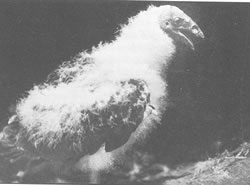 |
Black Vulture.
Photo by Gene Stratton-Porter |
One of her more exciting
studies involves the article, “A Study of the
Black Vulture,” published
in December 1901. A rare find in the 1900s, a vulture nest
was nearly impossible to spot and little was known about the
bird. Stratton-Porter visited the spot of the nest for weeks,
braving the terrible swamp
with its bugs and poisonous snakes to present a new perspective
on the often ill-regarded bird.
Stratton-Porter
describes her observations of animals' senses in the June
1902 issue of “Sight and Scent in Birds and
Animals” and creates a symphony of sounds with
her September 1902 article, “The Music of the
Marsh.”
With these articles Stratton-Porter
hoped to show people the often-overlooked beauty and complexity
of wildlife. She felt that the people of her time were too
concerned with propriety and social affairs, and she wanted
them instead to appreciate the natural world. She stressed
the importance of taking the time to observe nature to all
her readers, whether they lived in the city or the countryside.
Such opinions are found in the article, "Under
My Fig Tree," published
in The American Annual of Photography and Photographic
Times Almanac for 1903. For example:
There come at home days when I do not know
of a single location anywhere to tempt me abroad, and I
say to myself, “To-day, about my veranda and orchard
I will loaf and invite my soul.” It is of these days,
under my own vine and fig tree, when most interesting subjects
come and sit down in front of me, and as it were, compel
my camera from its case and my lens to action, that I wish
to write. (26)
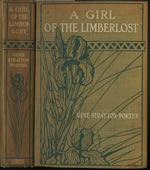 |
A Girl of
the Limberlost. Published by Doubleday Page and Company,
1909. |
In the February 1910 issue
of World’s Work Magazine, Stratton-Porter wrote
the article “Why I Wrote A Girl of the Limberlost.”
Letters poured in after the publication of this novel and
the public asked for more. Stratton-Porter wrote this article
in response. In this article, she again notes her desire to
bring the tranquility of nature and the forest
to the public:
So I wrote “A Girl of the Limberlost,”
to carry to workers inside city walls, to hospital cots,
to those behind prison bars, and to scholars in their libraries,
my story of earth and sky… I put in all the insects,
flowers, vines and trees, birds, and animals that I know….
(12546)
Stratton-Porter continued to write about Indiana’s
environment in popular magazines like Outing, Ladies Home
Journal, Good Housekeeping, and McCall’s
as well as many others, and showed people a new world waiting
in the swamps and forests.
Although Stratton-Porter
was sometimes criticized for being too sugary, this did not
stop readers from devouring her work. In 1921, she signed
a contract with McCall’s Magazine to write
a monthly article called the Gene Stratton-Porter Page.
As her audience was composed of mainly women, the articles
gave advice on housekeeping as well as addressing nature topics.
This column appeared in each issue of McCall’s from
1922-1927. Even after her death in 1924, the fans longed to
read all she had to say, and the remainder of her articles
were published posthumously. In December 1927, her final article,
"The Healing Influence of Gardens,"
was published in McCall's. In this article, her daughter addressed
the readers, making this statement about Stratton-Porter’s
feelings toward the fans:
 |
Jeannette Stratton-Porter,
1907.
|
I do not know which was dearer to my mother’s
heart – Nature, with all the wealth of color and beauty
that word implies – or you, women of America, two
million strong, to whom she spoke each month through this
page. That she loved you both I am certain. Her love for
Nature – for flowers, for fields, for streams, for
mountains, spoke through every word of her works. Her love
for you shone through her life and illuminated each tiny,
inconsequential daily task. You were always in her thoughts,
you women of McCall’s street; your problems
were her problems, your hopes her hopes and your triumphs
she made her own. My mother is gone, but her love and her
spirit, I am proudly confident, remain and will be forever
with you. (120)
Stratton-Porter wrote her articles to give people
a glimpse of the world outdoors. Their response to her editorials
was one factor in her decision to expand many of her articles
into books. For example, Freckles, Laddie, Moths of the
Limberlost, What I Have Done With Birds, and The
Song of the Cardinal all started out as articles. Stratton-Porter’s
readers loved her writings so much, that they demanded her
articles be published even after her death. Stratton-Porter
contributed to the environment and literature by creating
novels that educated as well as entertained their readers.
--DSS
Sources:
Cooper, Frederic Taber. "The
Popularity of Gene Stratton-Porter." The Bookman
9 (1915): 670-71.
Gene Stratton-Porter: A Voice
of the Limberlost. Producers Nancy Carlson and Ann Eldridge.
Perf. Annette O’Toole. Ball State University, 1996.
King, Rollin. Gene Stratton-Porter:
A Lovely Light. Chicago: Adams Press, 1979.
Long, Judith Reick. Gene Stratton-Porter:
Novelist and Naturalist. Indianapolis: Indiana Historical
Society, 1990.
Richards, Bertrand F. Gene Stratton-Porter.
Boston: Twayne, 1980.
Stratton-Porter, Gene. At the
Foot of the Rainbow. New York: Grosset & Dunlap,
1907.
---. Birds of the Bible.
Cincinnati: Jennings & Graham, 1909.
---. A Girl of the Limberlost.
New York: Grosset & Dunlap, 1909.
---. Freckles. New York:
Doubleday Page & Co., 1904.
---. The Harvester. New York:
Doubleday Page & Co., 1911.
---. Homing with the Birds:
The History of a Lifetime of Personal Experience with the
Bird. New York: Doubleday Page & Co.,1919.
---. Laddie: A True Blue Story.
New York: Grosset & Dunlap, 1913.
---. Let Us Highly Resolve.
New York: Doubleday Page & Co., 1927.
---. Moths of the Limberlost.
New York: Doubleday Page & Co., 1912.
---. Music of the Wild. Cincinnati:
Jennings & Graham, 1910.
---. The Song of the Cardinal.
New York: Doubleday Page & Co., 1915.
---. Tales You Won't Believe.
New York: Doubleday Page & Co., 1925.
---. What I Have Done with Birds:
Character Studies of Native American Birds. Rev.
ed. as Friends in Feathers. New York: Doubleday Page
& Co., 1917.
---. Wings. New York: Doubleday
Page & Co., 1923.
Vanausdall, Jeanette. Pride and
Protest: The Novel in Indiana. Indianapolis:
Indiana Historical Society, 1999.
(MAGAZINE
BIBLIOGRAHY)
Images:
Long, Judith Reick. Gene
Stratton-Porter: Novelist and Naturalist. Indianapolis:
Indiana Historical Society, 1990. 22, 23, 67, 101, 116, 156.
[Family photos and vulture picture.]
A Girl of the Limberlost.
Rave Reviews: Bestselling Fiction in America Exhibit, U of
Virginia Library. 15 November 2002 <http://www.lib.virginia.edu/speccol/exhibits/
rave_reviews/lg_html/1909-girloflimberlost-cove.html>.
Links:
Indiana
Historical Society: Gene Stratton-Porter
Gene Stratton-Porter
and Her Limberlost Swamp
|




